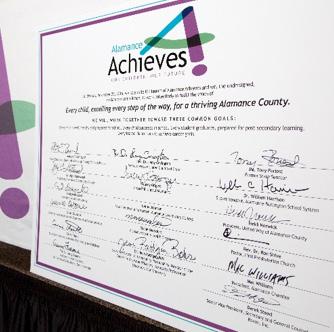2018 BASELINE REPORT





Realizing the vital need to improve outcomes for children in Alamance County, a group of cross-sector community leaders came together in 2015 to develop a plan of action. They partnered with StriveTogether , a nationally recognized organization that helps communities reach system-level outcomes, and started Alamance Achieves.
One of the group’s first steps, using the Strive framework, was to gather key “baseline” data about the current well-being of Alamance County’s children – from reading and math test scores, to high school graduation rates.


Alamance Achieves uses this data to show where needs exist in our community and how we are progressing to meet those needs. This Baseline Report describes the goals we are working toward and the types of data we are collecting – giving us our “starting point” in our journey to improve the outcomes for children in Alamance County.
In the coming years, we will use the information we gather to make sure we are on track with our goals. Alamance Achieves is a long-term movement that will leverage existing resources in the private and nonprofit sectors to ensure all children, young adults and families in Alamance County are supported from cradle to career.
This report would not have been possible without the work of the Outcomes Team , who studied the data to create core outcomes and indicators to be used to monitor the success of Alamance Achieves. Each outcome area was approved by the Alamance Achieves Steering Committee in 2016. The outcomes team also pointed out that creating a pathway for all children to succeed requires a supportive, engaged community.
We would also like to thank Alamance Community College and the Alamance-Burlington School System for contributing data.
Community members in the Outcomes Team identified the types of data needed to measure progress – and stressed the need for community support and engagement.
• Steve Achey , Alamance-Burlington School System
• Jenny Faulkner , Alamance-Burlington School System
• Stacie Saunders , Alamance County Health Department
• Cathy Johnson , Alamance Community College
• Carrie Theall , Alamance County Partnership for Children

• April Durr , United Way of Alamance County
• Kathy Coville , Cone Health/Alamance Regional Medical Center
LIVING WAGES, AFFORDABLE HOUSING

Alamance Achieves was created by and is made up of members of the community who want the best for our children and for our county. The initiative could not have come to fruition without the hard work of numerous community leaders, educators and business leaders who took the time to meet, gather data and share their insights to make this partnership work.
The backbone organization is the dedicated staff for Alamance Achieves. The staff oversees the day-to-day work of building the collective capacity of our community partners.

• Tyronna Hooker , Executive Director
• Alison Harman , Data Manager
• Barbara Massey , Collaborative Action Facilitator
• Charlie Bryant-Pardini , Collaborative Action Facilitator
Each year, the backbone staff will receive additional staffing support via the Kenan Community Impact Fellow program. This year, Alamance Achieves welcomes Bernadette Cooper and Daniela Ceron on board.
The Steering Committee oversees the initiative’s activities and consists of community members from all sectors of Alamance County. Please see page 10 for a complete list of members.
Impact Alamance serves as the anchor organization, which provides management oversight and financial support to the backbone staff. The United Way of Alamance County is also providing financial and leadership support.
The Community Transformation Council helps connect Alamance Achieves to key leaders and organizations in the private sector, health care, education, government, the faith community and the nonprofit sector to better align resources and leverage existing community assets. Together, we can.
For a complete list of members of the Council, please go to www.AlamanceAchieves.org

Above Left : Members of the Alamance Achieves staff (back row, left to right) Barbara Massey , Collaborative Action Facilitator; Charlie Bryant-Pardini , Collaborative Action Facilitator; and Alison Harman , Data Manager (seated) Tyronna Hooker , Executive Director.
Above Right : Community members pledge their support to Alamance Achieves during the launch in November 2016.


We are excited to continue to grow the impact of Alamance Achieves , a StriveTogether community partnership, whose goal is to see every child in Alamance County is educated, equipped, and engaged from cradle to career. We want all our children to receive the best education possible and be prepared to thrive.
Our goal is to work together to build the capacity of our community to dramatically improve educational outcomes for every child by providing strategic assistance and high-quality resources to organizations serving the community.

This report gives a snapshot of our children’s educational well-being at this moment in time. Community members and leaders gathered data on the health and education of all children in Alamance County to create goals, indicators and outcomes that we, as a community, will use to hold ourselves accountable to continue supporting our children for years to come.
The report outlines areas for improvement, and highlights practices and resources that are already working well in our county.
Our efforts will be concentrated on creating a culture of continuous improvement – a datadriven way to make progress toward a big goal by defining problems, establishing and testing strategies, and analyzing results. We learn as we go, making adjustments when needed. The resulting changes come not from a one-time action, but from coordinated, scaleable practices that are ongoing.
Please read, think about and discuss the information in this report. Every one of us — whether we are parents, caregivers, educators or community leaders — can play a role in helping our children find the resources they need to learn and grow.
By helping the youngest members of our community thrive, we are also taking steps toward a flourishing Alamance County . Please join us as we work together to ensure that Alamance Achieves!
Sincerely,
Alamance Achieves Steering CommitteeROBERT “BOB” BYRD Alamance County Commissioners
DR. WILLIAM HARRISON
Superintendent, Alamance-Burlington School System 1

HEIDI NORWICK
President, United Way of Alamance County
CARRIE THEALL
Executive Director, Alamance Partnership for Children
TONY FORIEST Former State Senator
DR. BRUCE BENSON Superintendent, Alamance-Burlington School System 2
SUSAN OSBORNE
Director, Alamance County Department of Social Services
DR. JEAN
RATTIGAN-ROHR
Executive Director of Community Partnerships, Director of the Center for Access and Success, Associate Professor of Education, Elon University
DR. GERRY FRANCIS Assistant to the President for Community Relations, Elon University
BRYAN HAGOOD Manager, Alamance County
STACIE SAUNDERS Director, Alamance County Health Department
DEREK STEED
Senior Vice President, Secretary and General Counsel, Glen Raven Inc.
TRACEY GRAYZER President, Impact Alamance
CATHY JOHNSON
Vice President of Instruction, Alamance Community College 3
REV. DR. RON SHIVE
Pastor, First Presbyterian Church
MAC WILLIAMS
President, Alamance Chamber



About one in three children in Alamance County lives in poverty, according to the 2014 Small Area Income Poverty Estimate.
Research has shown that children whose environment limits their access to healthy foods, safe places to play and quality schools are less likely to be ready for kindergarten, less likely to graduate from high school and less likely to get jobs that can support their families.
Breakthroughs in neuroscience mean that we now understand much more than ever before how it is that brains develop and children learn. Based on the data collected and research that shows there are crucial stages in a child’s development, Alamance Achieves has chosen to focus on four Key Goals to help Alamance children thrive:
KINDERGARTEN READINESS
EVERY CHILD IS WELL, HEALTHY AND READY FOR SCHOOL
ACADEMIC PROGRESS EVERY CHILD THRIVES IN SCHOOL

HIGH SCHOOL GRADUATION EVERY STUDENT GRADUATES, PREPARED FOR POST-SECONDARY LEARNING
CAREER SUCCESS EVERY LEARNER IS ON TRACK TO ACHIEVE CAREER GOALS
It is the goal of the Alamance Achieves collective impact partnership to align community organizations and resources around these goals to change outcomes for children.
To ensure our investments pay off, Alamance Achieves will hold itself accountable by using the baseline data in this report to continually assess progress and steer our efforts. The baseline data collected to create the four Key Goals had to meet certain criteria, including that it:
• represents community-wide factors that affect the entire Alamance County population
• is produced by a trusted source that will continually collect this data on a yearly basis
• is available consistently over time
• is a valid measure of the outcome areas our community is working to improve
• is able to be improved by local action
From the data collected, the Outcomes Team and the Steering Committee determined Core Indicators to measure progress in each of the four Key Goals, such as kindergarten readiness assessments and high school graduation rates.

They also identified Contributing Indicators that influence the environment and the systems around the Core Indicators. These include access to highquality pre-K programs and school attendance.
Core Indicators and Contributing Indicators for the four goals will be discussed in detail later in this report.
According to the NC Department of Public Instruction, the 2017 high school graduation rate of Alamance-Burlington School System was 82.4 percent, compared to the state rate of 86.5 percent.

What is Collective Impact? It’s when organizations from different sectors agree to work together to solve a complex problem. They develop a common agenda, align their efforts and use agreed-upon measures of success. Working together in a common direction leverages the power of their efforts.
Alamance County’s schools, nonprofits, government agencies, churches and other organizations are already working hard to help plug children into the resources and opportunities they need to grow and learn. Alamance Achieves helps to connect and align our community’s efforts and use data to measure progress and identify the areas that need more attention.
Numerous community organizations – including AlamanceBurlington School System , United Way of Alamance County , Alamance Community College , Impact Alamance , the First Presbyterian Church of Burlington and companies such as Glen Raven – have committed to coordinate resources and actions around the Core Indicators to improve outcomes for our children.
Collaborative Action Networks , or community teams, will be created around each of the four Key Goals: Kindergarten Readiness, Academic Progress, High School Graduation and Career Success. Each network will be responsible for plugging children into the existing resources and opportunities they need to succeed in their particular stage. The networks will use local data to continually assess progress and steer our efforts to improve patchy areas in the community’s “grid” of resources.
By giving all children access to the grid of resources our community offers — such as libraries, museums, schools, community centers, early learning programs, health care providers and more — every child can have a real opportunity to thrive.

Access to resources can help children become more resilient to negative events or situations, but the challenges that we are preparing our students to be able to face are multifaceted and complex. It only makes sense that we are going to need people with all kinds of expertise and from all walks of life to partner with our educators and be able to solve problems in innovative ways. It will also be critical to include community voices, including parents and youth, throughout the process. Often those closest to the problem have the solution.
When we are all aligned and focused on common outcomes , we can achieve true system change that impacts the students most in need, reinforcing our collective actions to create measurable results, continuous improvement and shared accountability.
In Alamance County, only 38 percent of entering kindergartners met developmental benchmarks in text comprehension at the beginning of 2017.


Children who are ready for kindergarten are more likely to thrive throughout school and to meet grade-level goals in reading and math down the road. When we focus on getting our kids ready for school, what we are really doing is creating a foundation that prepares our children to best acquire the skills that they will need to equip them to face the challenges of the next century.

Preparing our kids to be able to take advantage of the opportunities afforded by an education also ensures that our country will be able to draw upon everyone’s skills and capabilities. We all benefit when we do everything we can as a community to help our children show up to school ready to learn — ensuring that Alamance County will be better prepared for the future.
We believe that lifelong education begins at birth , not only when a child enters kindergarten. It takes strong community and family supports to build a child’s brain architecture and set the foundation for learning. The goal is to give all children access to the building blocks they need to be prepared for their first day of kindergarten. These building blocks include strong physical, social and emotional health, community-wide understanding of what is expected of

EVERY CHILD IS WELL , HEALTHY AND READY FOR SCHOOL
children at kindergarten entry, early exposure to literacy, and the opportunity to interact with other children in education-rich settings. Research shows strong correlations between early childhood health and educational progress, making early childhood a natural focus point for educational intervention.
If we fail to address barriers to access to learning opportunities, some areas of Alamance County will have access to education that equips them for the future and others will not. Our county cannot afford to limit its talent pool by having great differences in educational quality from place to place. We need to make sure that all students receive a fair share of educational resources, no matter where they live.
One Core Indicator for Kindergarten Readiness will be the baseline results from the new Alamance-Burlington School System Kindergarten Screener that is being piloted in the 2018-19 school year and will be implemented system-wide in fall 2019. The screener measures progress toward the county-wide definition of “kindergarten readiness” developed by Alamance Achieves Kindergarten Readiness Action Network and ABSS Kindergarten teachers:
Kindergarten readiness is a critical stage of early
development in the areas of social, emotional, academic and motor skills that enable a child to engage in and be empowered by school-based learning experiences.
Child health and well-being is an important part of school readiness. Networks around this goal are currently identifying the best Core Indicator measure and goals for wellness to support Kindergarten Readiness.

• Well-child visits
• Access to high-quality pre-K and/or licensed and regulated childcare
• Childcare subsidy wait list
• Percent of children identified with special needs receiving early intervention or special education services
• Birth outcomes and number of mothers who received timely prenatal care
• Number of children, aged 0-5, enrolled in specialized programs
38%
of entering ABSS kindergartners met developmental benchmarks in text comprehension in 2017*


Just like kindergarten readiness puts children on track to thrive, learning progress in elementary and middle school is critical for building a foundation for success throughout and after high school.

Networks around this goal will look at End-of-Grade (EOG) test scores for third and eighth grades as Core Indicators for performance in school. Students who do not meet grade-level standards are likely to need additional help in the next school year and are at risk of falling behind their peers.
ONLY AROUND HALF OF THIRD GRADERS ARE PREPARED TO MOVE UP TO FOURTH-GRADE MATH AND READING CLASSES.

Monitoring EOG test scores will help this network identify trends and close gaps in progress. By understanding the early impacts of educational interventions, we can work to address any problems by high school
The network will also look at the following:
• Attendance – research shows this to be a key indicator of educational progress

• Free and reduced lunch applications – used to show community’s level of financial need
• After school enrollment – can provide continued educational time, a social outlet and adult support for students

• Parental engagement – a support system has a strong impact on a child’s future
• Number of children enrolled in specialized programs – literacy, STEAM and engagement programs are focused on children learning with parents






Ahigh school diploma is a key indicator of a child’s chance of accomplishment in life.
Graduates have a better chance of earning admission to a college or university and are in a better position to find higher paying jobs with opportunities for career growth.
Networks around this goal will be measuring high school graduation rates and will examine local causes of disparities among groups of students in achieving graduation.
By measuring high school graduation rates, we can target support to areas in the community with lower graduation rates.

In 2017, 325 students in the 2013-2014 freshman class did not graduate high school — that’s greater than the entire graduating class of Western Alamance High School. However, graduation rates have risen steadily over the last 10 years -up from 70.8% in 2008. By measuring the percent of ABSS freshmen who graduate from high school four years later, we can target community supports in areas with lower graduation rates. About four of every five freshman graduate from high school in four years (82.4%). Graduation rates for economically disadvantaged students were lower at 75%.
In the current job market, individuals with postsecondary credentials and degrees have more opportunities for work with a living wage. For this reason, post-secondary enrollment was chosen as another Core Indicator
When graduates receive a working wage, they are better equipped to bring themselves out of poverty, contribute to society and provide for their families.
Networks around this goal will also look at enrollments in military, community college and career or technical pathways.
Factors that affect high school students’ ability to reach graduation include:
• Chronic absenteeism
• Teen pregnancy
• Drug and alcohol use
• Juvenile crimes
• FAFSA application completion
• Scholarship dollars awarded
• Pre-graduation enrollment in college
• Extracurricular activities
• ACT, SAT scores
• Number of students enrolled in AP classes


Following high school , young adults need additional support and continuing education to find a job with a living wage. Strong career goals are vital for every child to be engaged in our Alamance County community and have the opportunity to fully participate in society.

Networks centered around this goal will measure post-secondary completion as a Core Indicator This means keeping track of the number of Alamance students who complete some college courses, earn an associate degree or obtain a bachelor’s degree. Higher levels of education correlate to a greater number of career opportunities and improved wages.
POST-SECONDARY ENROLLMENT IN 2017
POST-SECONDARY COMPLETION IN 2016
Percent of residents 25 or older with an associate degree or higher.*
POST-SECONDARY COMPLETION BREAKDOWN
Unemployment rate for young adults is another Core Indicator . The unemployment rate was chosen as an indicator for achieving career goals because we hope to ensure that young adults are graduating and that businesses in the local economy are able to employ them.

Percent of young adults 20 to 24 who are unemployed: 4.1%
The average income for Alamance County residents with only a high school diploma earns $25,776 To make ends meet in Alamance County, a family of two needs $40,246 , and a family of four needs $59,169 1
Moving forward, the Career Success network will be looking at the education and experience needed for in-demand jobs in Alamance County and comparing it to the educational status of our young adults.

The network will also look at the following indicators that affect long-term career potential:

• Number of students being promoted from the first year of college to the second year
• Number of students earning high-school equivalency
• Incarceration rates
• Number of students graduating from Alamance Community College’s certificate, degree and diploma programs
• Number of students joining the military following high school graduation
• Number of students employed one year after graduating from college
It is the goal of the Alamance Achieves collective impact partnership to align community organizations and resources around four key goals to change outcomes for children. We measure Core Indicators and Contributing Indicators across life stages as children prepare for adulthood. Together, we can dramatically improve educational outcomes for every child from cradle to career by providing strategic assistance, network communications and high-quality resources.
Health well-beingand
ABSS Kindergarten Screener
High-quality pre-K and childcare Childcare subsidy wait list
Scholarship dollars awarded
FAFSA application completion
Special needs early intervention or education
Juvenile crimes
Postsecondary completion Unemployment rates
Students promoted from the 1st year of college to the 2nd year
Students earning high-school equivalency
